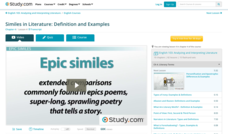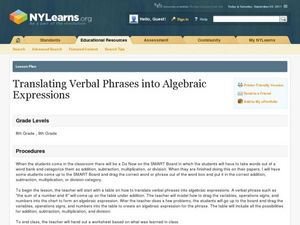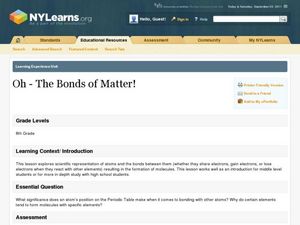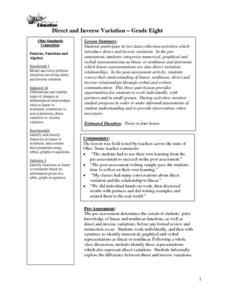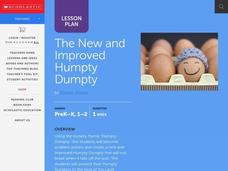Curated OER
Similes in Literature: Definition and Examples
Be as romantic as a poetic. Appear as clever as Einstein. Wow others with your powers of observation by using similes to point out the similar aspects in two different things. This short video focuses on similes found in Shakespeare and...
Curated OER
Cliches, Paradoxes
Clichés, paradoxes, and equivocations are detailed in a short, animated video that defines and illustrates these writing traps. The resource also includes a quiz and the transcript for the video. Users can register to access free course...
Curated OER
Coast-to-Coast Book Design-Part 1: What is a book?
In this first of four lessons on book design, young scholars are introduced to the vocabulary of book design through the use of bookwalks and a non-linear PowerPoint presentation in game-show (Jeopardy!) format.
Curated OER
The Life And Times Of The Apple
Students engage in a study about the biology of apples that includes growth and reproduction. They conduct research using a variety of resources. Students write a description of an apple brought to class by answering several questions....
Curated OER
Synecdoche vs. Metonymy: Definitions
Ask your class to lend their ears, and eyes, to a short video that defines and offers examples of synecdoche and metonymy. Whether it be brand names like Kleenex® and Band-aids® that have come to stand for all the products in a category,...
Curated OER
Creating Circle Graphs with Microsoft Excel
Students create graphs of circles. In this geometry lesson, students use Microsoft Excel to create graphs. They construct the graphs using paper and pencil as well as the computer.
Curated OER
Translating Verbal Phrases into Algebraic Expressions
Students rewrite word problems using algebraic symbols. In this algebra lesson, students graph linear equations after they rewrite the equation using algebra. They relate math to the real world.
Curated OER
Catalog Shopping
Young scholars, in groups, "shop" for eleven different items in a large mail order catalog. They locate the items and complete the order form. As a class, they discuss ways to find things more quickly.
Curated OER
Four Times Tables With A Number Line
In this four times tables activity, students first read the times tables in both words and numbers, 1-10, then complete a set of times tables, using a number line for help.
Curated OER
Oh - The Bonds of Matter!
Eighth graders identify the types of bonds elements form. In this chemistry lesson, 8th graders represent valence electrons with dot structures. They draw and label different atoms.
Curated OER
Money Bags
Students compare budgets of various federal agencies and graph the monetary relations between these top-funded agencies. They propose alternate budgets and justify their own monetary priorities.
Curated OER
Cultural "Art"-ifacts
Seventh graders explore how culture is reflected through art. After researching the art of a specific culture, 7th graders create replicas of art objects that reflect the ideals, values, and history of the culture.
Pennsylvania Department of Education
Analyzing Numeric and Geometric Patterns of Paper Pool
Students use concrete and pictorial representation of geometric patterns to extend patterns. In this geometric patterns lesson plan, students identify patterns and extend them.
Curated OER
Math Game Night
Young scholars plan a family game night. In this problem solving lesson, students brainstorm games to play, watch a video to help with room arrangement and determine which room arrangement would work best. When all the preparations are...
Curated OER
Times Tables Questions
For this multiplication worksheet, students solve 10 problems in which a multiplication problem is presented in words. Students then solve 10 problems in which a number (shown with an exponent of 2) is multiplied by itself.
Curated OER
Direct and Inverse Variation
Eighth graders participate in two data collection activities that involve direct and inverse variation. In the pre-assessment, 8th graders categorize numerical, graphical, and verbal representations as linear or nonlinear and determine...
Curated OER
Writing About Winter
Students investigate the concept of winter as a season and they write an essay as a reflection upon the acquiring of new information. The class should have a list of vocabulary or a word wall available for observation to aid in the...
Curated OER
Welcome to New York State
Students choose one region of New York state, and create a travel brochure that includes information such as geographical features, tourist attractions, accesibility, economic features, and historical events that occured in that region.
Curated OER
Play Ball!
Young scholars pretend as if they have been hired by the commissioner of Major League Baseball. Their task is to explain the mathematics of baseball so that more people enjoy the game.
Curated OER
Super Sort
Students sort objects based on one characteristic. They define the term "attribute" and give examples of attributes of objects. Students explain their reasoning for sorting objects into groups.
Curated OER
Multiplication: Building Models, Representations and Explanations
First graders explore multiplication concepts through skip counting, repeated addition and arrays. Using animal characteristics as a context, 1st graders solve problems using mathematical tools such as hundreds charts, number lines, ...
Curated OER
The New and Improved Humpty Dumpty
Students help Humpty Dumpty. In this nursery rhyme instructional activity, students listen to the nursery rhyme and then use their problem solving skills to rebuild broken eggs. Students create new Humpty Dumptys from unbreakable materials.
Curated OER
Using Your Melon for Math
Students apply fraction multiplication and division to recipe conversion.
Curated OER
How do We Treat Our Environment?
Seventh graders explore the concept of collecting data. In this data collection instructional activity, 7th graders survey others about their environmental habits. Students graph their data.


